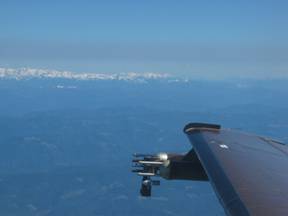
CIFEX Experiment #2
CIFEX Flight #2
April 2, 2004; 2:00-5:00pm
Flight Scientist: Eric Wilcox

There were still no clouds in the experiment area, so the flight plan called for a track outbound due west of Arcata to 240nm in the elevated dust layer expected at 10,000 to 12,000ft) and returning on the same track in the sulfate layer below 5000ft. On the outbound leg we flew over Trinidad Head at 1400 ft then climbed to 15,000 ft at 500 ft/min. CN concentrations over Trinidad Head and below 4000 ft were above 2000/cc. An elevated pollution layer was found between 4500 and 5000ft. No clear signal indicating a dense layer of dust was found between 9000-15000ft, though a thin layer of elevated dust was visible to the eye in the 9000-10,000ft level. The heavy dust layer from the day before has apparently moved east of the experiment area as predicted by the CFORS model, and though it was visible, it was not nearly as striking as the day before. We flew stretches at 12, 500ft, 9000ft, and 8500ft without finding a clear dust signal (CN=250-300/cc; PCASP=50-200/cc). High thin cirrus above at 200nm and dissipating low cumulus clouds to the south beyond 250nm.
At 240nm we descended to 2000ft. A thick sulfate layer was found at 4200-4800ft, with clean air below, followed by another polluted layer starting at 2500ft and well mixed down to at least 1000ft. We flew a stretch at 2000ft measuring CN at about 2000/cc and PCASP concentrations at 300-400/cc. When the CN declined to 1500/cc we ascended to find the elevated sulfate level at 4500ft. We found CN concentrations at only 300/cc from 2900-5000ft. Therefore, there is some spatial variability to this elevated layer. Returning to 2000ft CN concentrations spiked to nearly 10,000/cc. When the CN had declined to 6000/cc, we ascended again to look for an elevated level. The top of the lower pollution layer was found at about 2800ft, then a broad layer of elevated pollution was found 4000-8000ft with concentrations increasing toward the coast 500-1500/cc. Some variability in the SMPS particle size distribution was noted by Glenn.